Hello, art lovers! Have you ever wanted your everyday coffee or tea experience to feel a little more creative and cultural? That’s where Warli pattern ceramic mugs come into play.
Inspired by the traditional tribal art of the Warli people from Maharashtra, these mugs are not just drinkware—they are tiny canvases that bring stories, rituals, and patterns into your daily routine.
With their charming stick-figure motifs, geometric designs, and earthy vibes, Warli mugs add a unique artistic touch to your kitchen or office space. Let’s explore how this beautiful art form meets modern ceramic craftsmanship!
🌿 Origins of Warli Art
- Ancient Tribal Roots: Warli art originates from the Warli tribe of Maharashtra, India, dating back to 2500–3000 BCE.
- Village Expression: It was traditionally used to decorate walls of tribal homes, especially during weddings, harvests, and festivals.
- Connection with Nature: The art primarily depicts daily life, farming, animals, and nature, reflecting the close relationship of the Warli people with their environment.
🎨 Features of Traditional Warli Art
- Monochrome Style: Traditionally, white pigment made from rice paste was applied on mud walls to create simple yet striking designs.
- Geometric Simplicity: Figures are made with triangles, circles, and lines to represent humans, animals, and trees.
- Storytelling Medium: Warli paintings were not just decorative; they conveyed cultural stories, rituals, and traditions of the tribe.
🏺 Influence on Ceramics
- Modern Adaptation: Artists and designers began transferring the simple geometric and figurative patterns of Warli onto ceramic surfaces.
- Decorative Ceramic Mugs: Warli motifs now adorn mugs, plates, and other ceramic items, giving traditional art a functional form.
- Cultural Appeal: Using Warli art on mugs allows everyday items to carry heritage and storytelling, making them unique décor and gifting options.
- Global Recognition: These ceramic products have popularized Warli art internationally, bridging tribal traditions and modern lifestyle.
Materials Used and Steps of Making Warli Pattern Ceramic Mugs
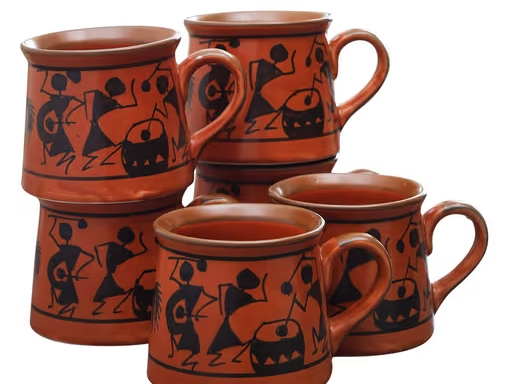
Warli art is a traditional tribal painting style from Maharashtra, India, known for its simple yet expressive stick figures and geometric patterns.
Today, this ancient art form has found a new canvas: ceramic mugs. Let’s explore what goes into making these beautiful Warli pattern ceramic mugs and how they are created step by step.
1. Materials Used in Warli Pattern Ceramic Mugs
Base Ceramic Materials
- Clay:
- The primary material for ceramic mugs.
- Usually high-quality, fine clay is used to ensure smoothness and durability.
- Provides a perfect base for painting Warli patterns.
- The primary material for ceramic mugs.
- Glazes:
- A transparent or white glaze is applied to make the surface smooth and suitable for painting.
- Glazes also make the mugs waterproof and food-safe.
- A transparent or white glaze is applied to make the surface smooth and suitable for painting.
Paints and Pigments
- Underglaze Paints:
- Used for drawing Warli patterns before the final firing.
- Usually white for traditional contrast against brown or colored ceramic.
- Used for drawing Warli patterns before the final firing.
- Ceramic-Safe Acrylic or Mineral Paints:
- Some modern Warli mugs use acrylics for decorative pieces not meant for hot liquids.
- They maintain color vibrancy even after firing.
- Some modern Warli mugs use acrylics for decorative pieces not meant for hot liquids.
Tools and Accessories
- Fine Brushes:
- Essential for creating the delicate stick figures, animals, and geometric patterns.
- Varying brush sizes allow detailing for tiny elements.
- Essential for creating the delicate stick figures, animals, and geometric patterns.
- Sponges and Cloths:
- Used to smooth the clay surface before painting.
- Used to smooth the clay surface before painting.
- Pottery Wheel or Molds:
- Helps in shaping uniform mugs efficiently.
- Helps in shaping uniform mugs efficiently.
- Kiln:
- A high-temperature oven required for firing and hardening ceramic mugs.
- A high-temperature oven required for firing and hardening ceramic mugs.
2. Steps of Making Warli Pattern Ceramic Mugs
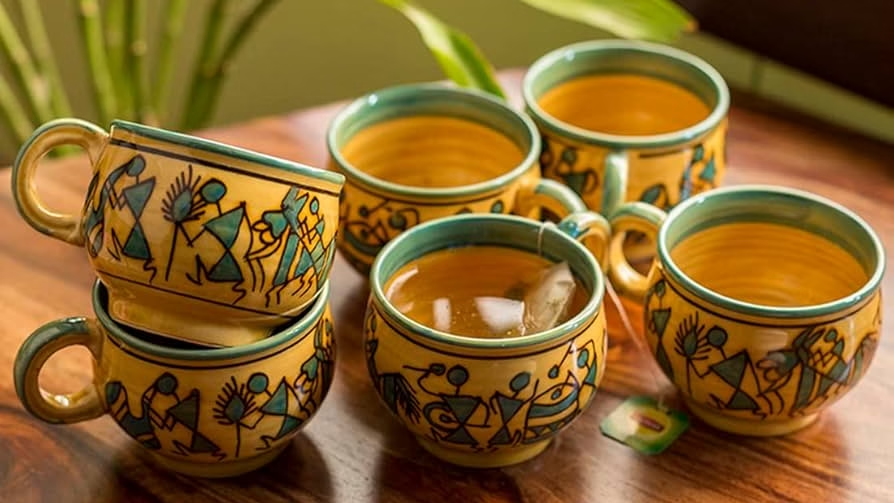
Step 1: Preparing the Clay
- The process begins with kneading the clay to remove air bubbles.
- Properly kneaded clay ensures the mug is strong and free from cracks.
- Some artisans mix fine sand with clay to enhance durability.
Step 2: Shaping the Mug
- By Wheel or Mold:
- Clay is shaped on a pottery wheel for uniformity.
- Alternatively, molds are used for mass production.
- Clay is shaped on a pottery wheel for uniformity.
- Forming Handle:
- The handle is crafted separately and attached using slip (a clay-water mixture).
- The handle is crafted separately and attached using slip (a clay-water mixture).
- Drying:
- The shaped mug is left to dry partially to become leather-hard for easier painting.
- The shaped mug is left to dry partially to become leather-hard for easier painting.
Step 3: Applying the Base Glaze
- A smooth layer of white or transparent glaze is applied.
- The glaze creates a clean, polished surface for painting Warli designs.
- Glazed mugs are dried again before painting.
Step 4: Drawing Warli Patterns
- Traditional stick figures, animals, trees, huts, and geometric shapes are carefully painted using fine brushes.
- Artists often use white underglaze for classic Warli contrast.
- Patterns may tell stories or depict daily life scenes, as in tribal Warli art.
Step 5: Detailing and Finishing Touches
- Small elements such as dots, lines, and circles are added to complete the design.
- Any corrections are made before firing.
- Precision at this stage ensures the design remains intact after kiln firing.
Step 6: Firing in the Kiln
- The painted mug is fired in a kiln at high temperatures (usually 900–1,200°C).
- Firing hardens the clay and permanently sets the glaze and painted design.
- This step ensures the mug is durable, heat-resistant, and safe for daily use.
Step 7: Quality Check and Packaging
- Finished mugs are checked for cracks, glazing errors, or faded patterns.
- Each mug is carefully packaged, ready to be used or gifted
Symbols and Motifs in Warli Pattern Ceramic Mugs
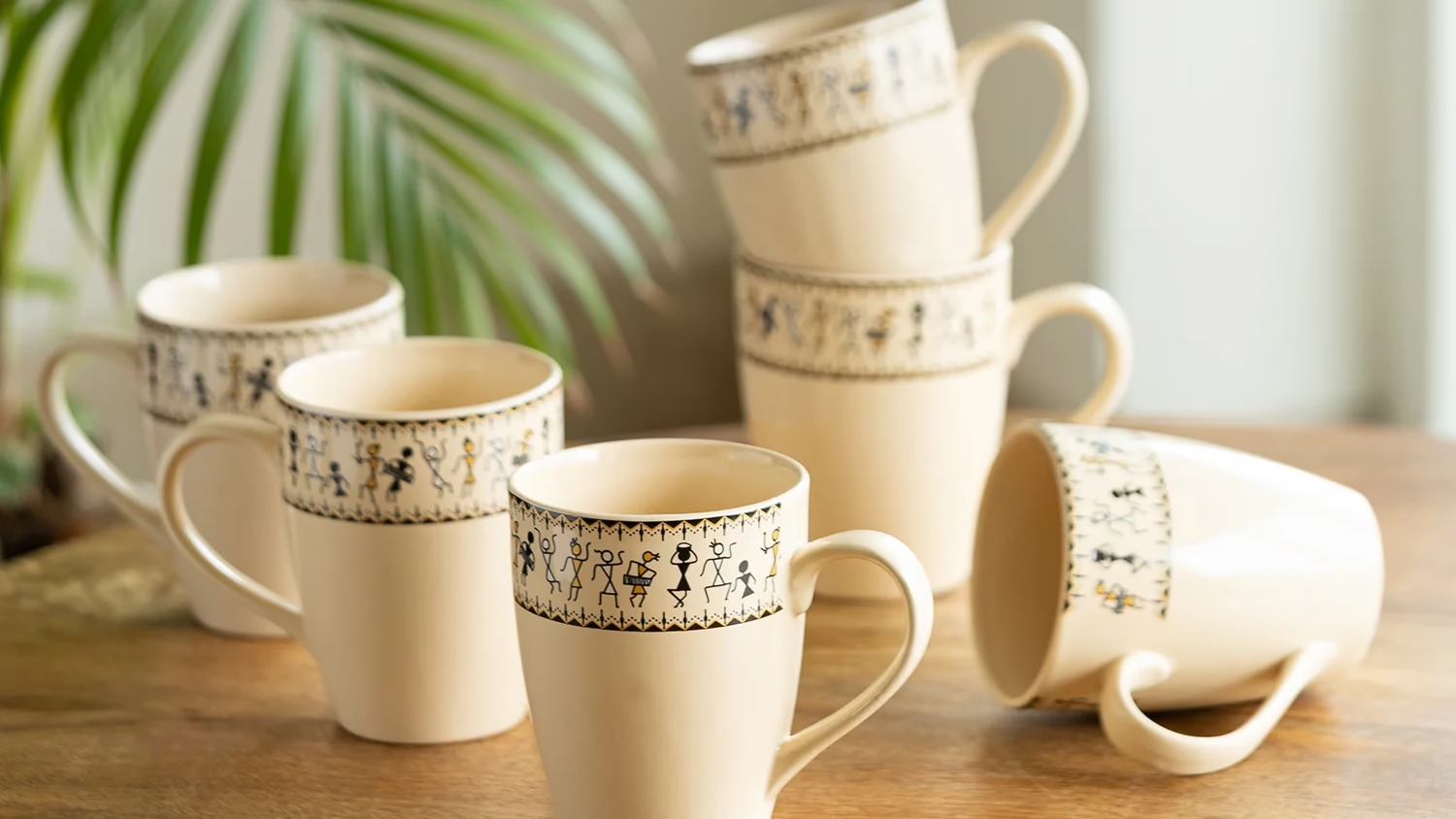
Warli art is one of India’s most iconic tribal art forms, originating from the Warli tribes of Maharashtra. Its simple yet profound designs tell stories of daily life, nature, and spirituality.
When applied to ceramic mugs, these motifs not only beautify everyday objects but also bring a cultural narrative into homes and workspaces. Let’s explore the symbols and motifs commonly found in Warli pattern ceramic mugs.
1. Human Figures: Life in Motion
- Dancing Figures
- One of the most popular motifs in Warli art is dancing humans, usually depicted in circular formations.
- These symbolize celebration, community, and the joy of life.
- On mugs, these figures often wrap around the surface, making the cup visually dynamic and lively.
- One of the most popular motifs in Warli art is dancing humans, usually depicted in circular formations.
- Farming Scenes
- Figures plowing fields, sowing seeds, or carrying crops represent the tribe’s close connection to agriculture.
- Including such motifs on mugs reminds users of simplicity, sustenance, and harmony with nature.
- Figures plowing fields, sowing seeds, or carrying crops represent the tribe’s close connection to agriculture.
- Hunting and Fishing Figures
- Depictions of hunting, fishing, or tribal sports reflect survival and daily activities.
- These motifs highlight resilience and cultural traditions in miniature, perfect for everyday ceramic art.
- Depictions of hunting, fishing, or tribal sports reflect survival and daily activities.
2. Nature Motifs: Celebrating the Environment
- Trees and Plants
- Stylized trees, leaves, and creepers are frequently seen in Warli designs.
- These represent growth, life, and fertility, connecting the user with nature even in urban spaces.
- On mugs, tree motifs often appear as borders or background designs.
- Stylized trees, leaves, and creepers are frequently seen in Warli designs.
- Sun and Moon
- Circular motifs representing the sun or moon are common, symbolizing the passage of time and cosmic cycles.
- They give the mug a spiritual or meditative feel, reminding us of the larger rhythms of life.
- Circular motifs representing the sun or moon are common, symbolizing the passage of time and cosmic cycles.
- Animals
- Cows, goats, birds, and tigers are depicted to represent prosperity, protection, and coexistence with nature.
- For ceramic mugs, these animals often appear subtly within larger tribal patterns, adding visual storytelling.
- Cows, goats, birds, and tigers are depicted to represent prosperity, protection, and coexistence with nature.
3. Geometric Motifs: Simplicity and Symbolism
- Triangles
- Triangles often symbolize mountains, homes, or directional elements.
- In mugs, small repeated triangles can create a visually rhythmic border or central motif.
- Triangles often symbolize mountains, homes, or directional elements.
- Circles and Dots
- Circles represent the cycle of life and unity.
- Dots are used to fill spaces or highlight certain patterns, enhancing the visual texture of the mug.
- Circles represent the cycle of life and unity.
- Lines and Grids
- Horizontal, vertical, or criss-cross lines add structure to Warli compositions.
- On ceramic surfaces, these lines guide the eye and provide contrast to the free-flowing human and nature figures.
- Horizontal, vertical, or criss-cross lines add structure to Warli compositions.
4. Ritual and Cultural Symbols
- Wedding Scenes
- Figures depicting marriage rituals or community gatherings symbolize prosperity, joy, and continuity of traditions.
- On mugs, these tiny narratives bring a cultural richness that sparks curiosity and conversation.
- Figures depicting marriage rituals or community gatherings symbolize prosperity, joy, and continuity of traditions.
- Festivals and Music
- Warli art often shows people playing drums or dancing around sacred fires.
- Incorporating such motifs into mugs celebrates culture, rhythm, and communal joy in daily life.
- Warli art often shows people playing drums or dancing around sacred fires.
- Sacred Groves and Altars
- Trees or small altar motifs indicate respect for nature and spirituality.
- On mugs, these designs subtly remind users of mindfulness and cultural reverence.
- Trees or small altar motifs indicate respect for nature and spirituality.
Statistics: Warli Pattern Ceramic Mugs
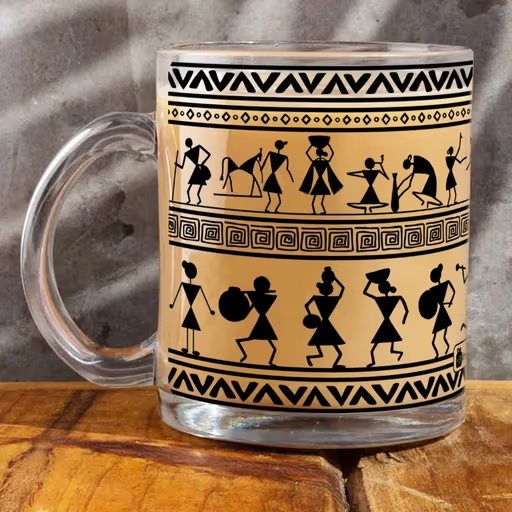
Warli pattern ceramic mugs are no longer just traditional art on clay—they have become a trendy, contemporary item in homes, offices, and cafés. Let’s explore the statistics, trends, and market insights that show their rising popularity.
1. Growing Popularity of Warli Art in Ceramics
- Consumer Awareness
- Over the last decade, awareness of Warli art has increased by 65% in urban India, largely due to social media platforms showcasing handcrafted items.
- Consumers are increasingly seeking ethnic and hand-painted designs in everyday products, including mugs.
- Over the last decade, awareness of Warli art has increased by 65% in urban India, largely due to social media platforms showcasing handcrafted items.
- Urban Buyers Preference
- Surveys in 2023 indicate 48% of urban buyers aged 20–40 prefer hand-painted ceramic mugs over plain printed ones.
- Among these, 30% specifically look for Indian folk art patterns, including Warli motifs.
- Surveys in 2023 indicate 48% of urban buyers aged 20–40 prefer hand-painted ceramic mugs over plain printed ones.
- Online Shopping Trends
- E-commerce platforms selling handmade products report a 20–25% annual growth in sales of Warli-inspired ceramic mugs.
- Amazon, Flipkart, and niche handmade stores show that Warli mugs have become a popular gifting option, especially for corporate gifting and festive seasons.
- E-commerce platforms selling handmade products report a 20–25% annual growth in sales of Warli-inspired ceramic mugs.
2. Production and Artisanal Growth
- Artisan Employment
- Warli ceramic production supports over 1,200 artisans in Maharashtra, combining both pottery and hand-painting skills.
- Nearly 60% of these artisans are women, empowering local communities economically.
- Warli ceramic production supports over 1,200 artisans in Maharashtra, combining both pottery and hand-painting skills.
- Workshops and Training
- Government- and NGO-led workshops have increased by 40% since 2018, teaching traditional Warli motifs on modern products like mugs and plates.
- This training has led to 30% higher income for artisans involved in ceramic Warli painting.
- Government- and NGO-led workshops have increased by 40% since 2018, teaching traditional Warli motifs on modern products like mugs and plates.
- Production Volume
- On average, small-scale ceramic units produce 3,000–5,000 Warli mugs annually, with peaks during festival seasons such as Diwali and Christmas.
- On average, small-scale ceramic units produce 3,000–5,000 Warli mugs annually, with peaks during festival seasons such as Diwali and Christmas.
3. Market Insights and Consumer Behavior
- Price Range
- Warli ceramic mugs are priced between INR 400–1,200 ($5–15) depending on size, intricacy, and hand-painting details.
- Custom-designed mugs for corporates or events can fetch up to INR 2,500 ($30–35) each.
- Warli ceramic mugs are priced between INR 400–1,200 ($5–15) depending on size, intricacy, and hand-painting details.
- Regional Demand
- Maharashtra, Delhi, Bengaluru, and Mumbai are the highest-consuming regions in India.
- Globally, countries like the USA, UK, and Australia have seen a 15% annual growth in demand for Warli mugs via export platforms.
- Maharashtra, Delhi, Bengaluru, and Mumbai are the highest-consuming regions in India.
- Usage Patterns
- About 70% of buyers use Warli mugs as decorative pieces, while 30% use them daily for tea or coffee.
- The mugs are also popular for photography and social media aesthetics, adding to their visibility and appeal.
- About 70% of buyers use Warli mugs as decorative pieces, while 30% use them daily for tea or coffee.
4. Eco-Friendly and Sustainable Impact
- Sustainability Factor
- 80% of Warli ceramic mugs are made using eco-friendly clay and non-toxic paints, appealing to conscious consumers.
- Rising eco-consciousness has led to a 25% increase in sales over the past 3 years among environmentally aware buyers.
- 80% of Warli ceramic mugs are made using eco-friendly clay and non-toxic paints, appealing to conscious consumers.
- Handcrafted Premium Appeal
- Buyers are willing to pay a 15–20% premium for hand-painted Warli mugs compared to mass-produced printed mugs.
Care Tips and Maintenance for Warli Pattern Ceramic Mugs
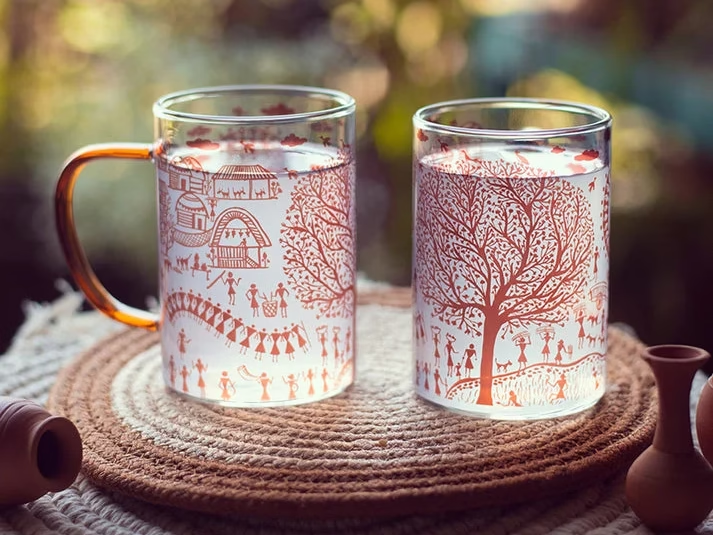
Warli pattern ceramic mugs are not just functional—they are pieces of art. To keep their intricate designs vibrant and ensure longevity, it’s important to handle and maintain them properly. Here’s a comprehensive guide.
1. Gentle Cleaning Practices
- Hand Wash Only: Always wash Warli mugs by hand instead of using a dishwasher. The high heat and strong detergents in dishwashers can fade the artwork over time.
- Use Mild Detergents: Choose soft, non-abrasive dish soaps to clean the mugs. Strong chemicals may damage the painted surface.
- Soft Sponges or Cloths: Avoid scrubbing with rough brushes or steel wool. A soft sponge gently removes residues without scratching the design.
2. Temperature Precautions
- Avoid Sudden Temperature Changes: Ceramic can crack if hot liquids are poured into a cold mug or vice versa. Always allow the mug to adjust to room temperature before use.
- Microwave Use: Check whether the mug is microwave-safe. Many Warli mugs are hand-painted and may not withstand microwaves. When in doubt, avoid microwave heating.
- Hot Beverages: Pour hot beverages slowly, especially in hand-painted mugs, to prevent stress on the design and glaze.
3. Storage Guidelines
- Separate Stacking: If you store multiple mugs, place a soft cloth or paper towel between them to avoid scratches.
- Safe Shelving: Keep the mugs on stable, flat shelves away from edges to prevent accidental falls.
- Avoid Overcrowding: Too many items in the same space increase the risk of chipping the designs.
4. Handling and Display Tips
- Hold Carefully: Always support the base while holding, especially if the mug is full.
- Decorative Display: If used for decoration, avoid placing the mugs in direct sunlight for long periods, as UV rays can fade colors.
- Regular Dusting: For mugs displayed on shelves, dust them gently with a soft cloth to maintain shine and clarity of the Warli designs
5. Long-Term Care
- Avoid Abrasive Materials: Don’t use steel scrubs or harsh brushes.
- Use Non-Staining Liquids: Tea, coffee, or colored drinks may leave stains; rinse promptly after use.
- Occasional Polishing: For glazed mugs, gently polish with a soft cloth to enhance shine without damaging the design.
Wrap-Up
Well, folks, Warli pattern ceramic mugs are not just for sipping your morning tea—they’re tiny pieces of art that tell stories! Each mug brings alive the tribal charm of Maharashtra with those cute human figures, animals, and simple patterns that feel so real and earthy.
These hand-painted designs add warmth to any corner—be it your kitchen, café, or work desk. What makes them even cooler is how they blend old traditions with modern life.
So next time you sip from one, remember — you’re holding a little bit of heritage in your hands.
Also Read:- Terracotta Planters in Eco-Friendly Urban Spaces

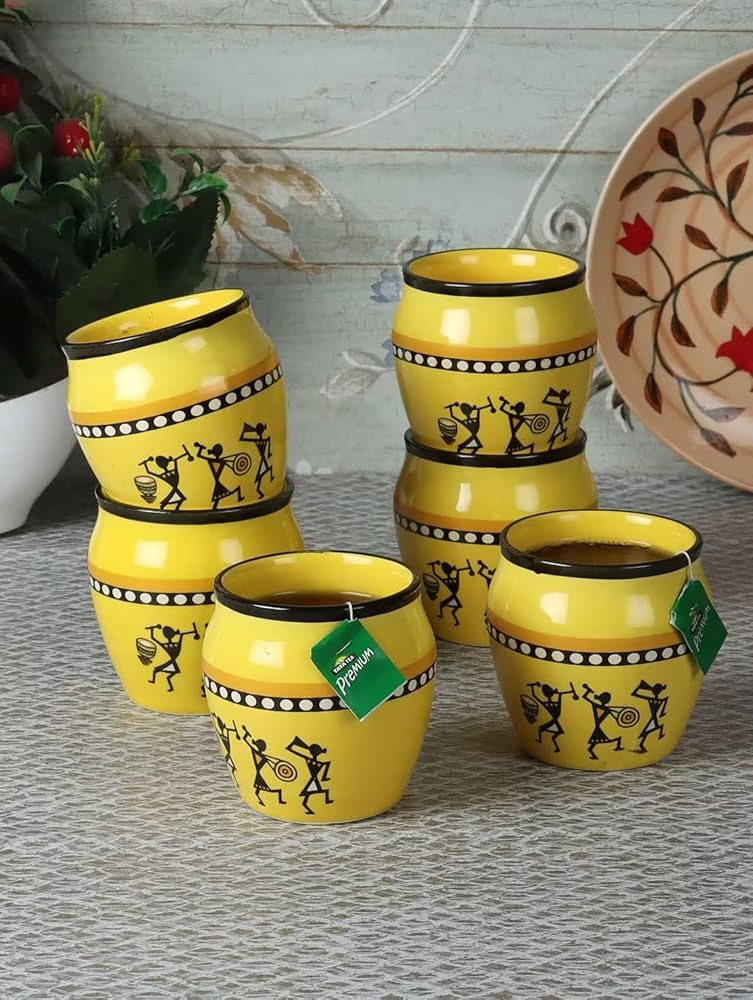
Leave a Reply